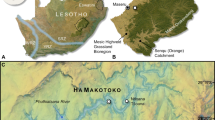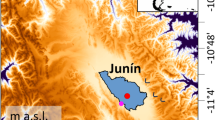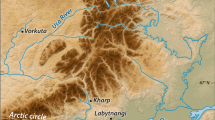Abstract
THE survival of the Teesdale rarities through the Flandrian period1, during the prominence of inimical conditions that led to the development of woodland and blanket peat and the podsolization of the soil, suggests either that the present habitats have provided similar conditions since the widespread distribution of the rarities in Late Glacial times2 or that the habitats are of recent origin and the plants survived elsewhere3. Neither of these hypotheses is based on the ecological history of Upper Teesdale but on a comparison of the present flora with that of Late Glacial times in other areas and on the assumption that the vegetational history of Upper Teesdale has followed a similar course to that of other floristically rich areas (for example, Ben Lawers4, Cwm Idwal5).
This is a preview of subscription content, access via your institution
Access options
Subscribe to this journal
Receive 51 print issues and online access
$199.00 per year
only $3.90 per issue
Buy this article
- Purchase on Springer Link
- Instant access to full article PDF
Prices may be subject to local taxes which are calculated during checkout
Similar content being viewed by others
References
Shotton, F. W., and West, R. G., Proc. Geol. Soc. Lond., 1656, 155 (1969).
Pigott, C. D., J. Ecol., 44, 545 (1956).
Bellamy, D. J., Bridgewater, P., Marshall, C., and Tickle, W. M., Nature, 222, 238 (1969).
Donner, J. J., Commentat. Biol., 25, (1962).
Godwin, H., Svensk Bot. Tidskr., 49, 35 (1955).
Squires, R. H., thesis, Univ. Durham (1970).
Johnson, G. A. K., The Geology of Moor House (HMSO, London, 1963).
Godwin, H., The History of the British Flora (Cambridge University Press, London, 1956).
Bellamy, D. J., Bradshaw, M. E., Millington, G. R., and Simmons, I. G., New Phytol., 65, 429 (1966).
McVean, D., J. Ecol., 44, 331 (1956).
Pearsall, W. H., Mountains and Moorlands (Collins, London, 1950).
Yapp, W. B., NWest Nat., 192 (1953).
Auer, A., Peat Bogs in South-East Canada (Canad. Dept Mines Geol. Survey, 1930).
Harris, T. M., J. Ecol., 46, 447 (1958).
Dimbleby, G. W., Proc. Roy. Soc. B, 161, 355 (1968).
Smith, A. G., Proc. Linn. Soc., 172, 38 (1961).
Simmons, I. G., New Phytol., 68, 607 (1969).
Simmons, I. G., in The Domestication and Exploitation of Plants and Animals (edit. by Ucko, P. J., and Dimbleby, G. W.) (Duckworth, London, 1969).
Horuung, M., thesis, Univ. Durham (1968).
Hewetson, V. P., thesis, Univ. Durham (1970).
Bellamy, D. J., and Rieley, J., Oikos, 18, 1 (1967).
Pennington, W., The History of the British Vegetation (Allen and Unwin, London, 1969).
Shimwell, D. W., thesis, Univ. Durham (1969).
Author information
Authors and Affiliations
Rights and permissions
About this article
Cite this article
SQUIRES, R. Flandrian History of the Teesdale Rarities. Nature 229, 43–44 (1971). https://doi.org/10.1038/229043a0
Received:
Revised:
Issue Date:
DOI: https://doi.org/10.1038/229043a0
Comments
By submitting a comment you agree to abide by our Terms and Community Guidelines. If you find something abusive or that does not comply with our terms or guidelines please flag it as inappropriate.



